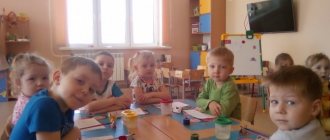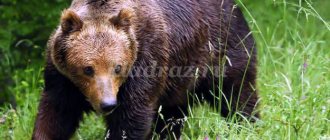Lesson summary for the second junior group on the topic: Healthy lifestyle
Lesson notes for the second junior group.
Topic: “Let’s teach Mishutka to take care of his health”
Integration of educational areas: “Cognition”, “Communication”, “Socialization”, “Health”, “Artistic creativity”.
Author: teacher Elizarova Irina Stanislavovna, MB pre-school educational institution CRR DS “Zvezdochka”, Kondopoga. Program content: 1. To consolidate ideas about acceptable children’s understanding of ways to strengthen and maintain health (morning exercises, walks in the fresh air, eating vegetables and fruits, vitamins). 2. Continue to lead children to the ability to understand object models. 3. Exercise in distinguishing some vegetables (garlic) and fruits (apple) with the participation of analyzers (smell and taste). 4. Contribute to the activation of children’s vocabulary through the use of words - different parts of speech; develop dialogical forms of speech (understanding of addressed speech, answers to asked questions). 5. Strengthen the skill of drawing with a “poke” (“vitamins”), placing the image over the entire silhouette. 6. Foster a desire to take care of your health and the health of others. Materials for the lesson: Toy Bear (bibabo), screen, cup and saucer, honey, spoon, subject pictures: “morning exercises”, “walk”, head of garlic, apple, plate, napkins, jar “for the smell of garlic”, toothpicks number of children for pieces of apples, a jar of vitamins, object models;
Equipment for painting: pokes, stands, gouache, oilcloth, napkins, silhouettes of jars, paint plates. Progress of the lesson:
1. Organizational moment: “All the children gathered in a circle. I am your friend and you are my friend. Let’s hold hands tightly and smile at each other” 2. Game technique: a little bear cub is grunting behind the screen V.: Who could it be? (a bear cub appears from behind the screen). Hello, Mishutka! It's so good that you came to us. M.: (coughs) - Hello, guys! V.: Mishutka, will you sing us a funny song or play a game? M.: No, I don’t want to (coughs) V.: Guys, what happened to Mishutka, what do you think? (children's assumptions). Mishutka caught a cold. Drink Mishutka tea with honey, and the cough will quickly go away (we serve a cup, Mishutka “drinks”). M.: Thank you! Q: Guys, why do you think Mishutka got sick? (children's assumptions). Mishutka, do you know how to take care of your health? (Mishutka shakes his head). Then listen and watch carefully. The guys and I will tell you and show you what you need to do to avoid getting sick. 3. A story about ways to strengthen and maintain health. V.: (the teacher turns the children to the picture) Look carefully and tell me what the girl is doing? (the girl does exercises). What about you and I, when do we exercise? (in the morning, when we arrive at kindergarten). Shall we show Mishutka our exercises? Come out to me, stand comfortably so as not to disturb each other. Physical education minute. Every day we do exercises in the morning. We really like to do everything in order (they go on the spot). Raise your arms, lower your arms, squat and stand, jump and gallop (movements according to the text) - repeat 2 times. V.: Well done! Guys, so that both you and Mishutka can better remember what is good for your health, I will place picture tips on the board. Do you agree? (show the model to the children).
To be healthy, you need to do exercises in the morning (we hang the model on the board). V.: (we invite the children to go to the next picture) Who are drawn in this picture? (children). What are boys and girls doing? (play, walk on the street). You and I also go for a walk every day. What do we do on a walk (children’s answers) - picture prompt on the board.
V.: And we also breathe fresh air while walking. What do we breathe? (nose). Let's show Mishutka how to breathe correctly: close her mouth, inhale through her nose, exhale. and to make your nose breathe better, this exercise is useful: breathe through one nostril, then the other (breathing exercises, repeat 2 times). Well done! And the nose can distinguish different smells. Let's try to guess the smell of one health secret? (the teacher quietly takes a jar with the smell of garlic, the children sniff). Can you guess what it is? That's right, it's garlic. Mishutka. Shall we give it a sniff? (Mishutka sniffs, brrr, shakes his head). Mishutka, garlic is a very healthy vegetable (opens a napkin and there is a head of garlic on the plate). Guys, tell Mishutka why you need to eat garlic? (children's answers). That's right, garlic is good for health - picture hint for the board.
The teacher invites the children to sit on chairs. Q: Guys, tell me, are fruits good for health? (children's answers). What fruits do you know? (children's answers). I also have fruit on my plate, try to guess what it tastes like? Just let’s give Mishutka a try first. Help yourself, Mishutka, please (the little bear tries it and smacks his lips). V.: Have you guessed, Mishenka, what kind of fruit it is? (Mishutka shakes his head). Now let the guys try to guess. Close your eyes, open your mouth (the teacher gives the children a piece of apple). Can you guess what kind of fruit this is? (children's answers). An apple is a fruit, and fruits are very healthy, they contain a lot of vitamins - picture hint for the board.
The teacher shows the children a jar of vitamins. Q: What do you guys think is in this jar? (children's answers). That's right, vitamins. They are good for health. We take one vitamin every day. Maybe we can give Mishutka some vitamins? (speaks and opens the jar). But there are very few of them here? (shows it to the children or pours it onto a plate). What do we do? (children's assumptions). Maybe we can draw some vitamins for Mishutka? (children's answers). The children agree, the teacher suggests approaching the tables. 4. Preparation for drawing, productive activity of children. V.: Look, there are jars on the tables. We will draw vitamins on them. What are we going to draw with? (poking). Take the poke. Let's first try to draw vitamins without paint (comment: the poke is jumping like a ball, we'll draw all over the jar). Now dip the poke in the paint and draw vitamins (while working, you can ask the children what color are the vitamins? What shape are they? Remind them that they need to draw vitamins all over the jar, there should be a lot of them). V.: Take the jars and take them to Mishutka (children place the drawings on the table in front of the screen). Well done, guys, how many jars of vitamins Mishutka now has - a picture hint for the board.
5. Analysis of the lesson. Q: What did we teach Mishutki today? (children's answers: take care of your health so as not to get sick). Let us repeat once again for Mishutka what needs to be done (according to the models - do exercises, walk more in the fresh air, eat garlic and fruits, take vitamins - one per day). V.: Do you remember, Mishutka? M.: Thanks, guys! I will try to follow your advice so as not to get sick and I will tell all my forest friends. It's time for me to leave, goodbye guys! (hides behind the screen). D.: Goodbye, Mishutka. V.: Be healthy, you guys too. Well done to you all today! Let's clap our hands and praise ourselves.
We recommend watching:
Summary of an integrated lesson in the younger group. Fair Lesson notes for the junior group: Trees in the snow GCD cognition in the junior group of kindergarten. Cultural and hygienic skills Summary of OOD on social and communicative development in the junior group
Similar articles:
Summary of GCD in the 2nd junior group on the topic: Autumn





